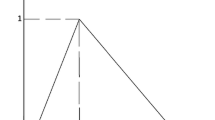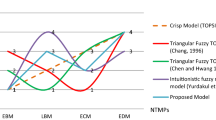Abstract
High-strength steel alloys, titanium, ceramics, composites are in the group of materials that are hard to machine. Conventional manufacturing techniques are not sufficient to machine these materials. For this reason, these materials are generally machined with non-conventional manufacturing methods. In this study, a fuzzy application of Best–Worst method and a novel hybrid decision-making model (Best–Worst decision-making approach with fuzzy TOPSIS) are proposed to solve different non-traditional machining method selection problems which were taken from the literature. Using these models, the Best–Worst method shortens the steps of solutions in the fuzzy environment compared to the AHP/ANP-based fuzzy solutions in the literature. The proposed models produce successful results.

Similar content being viewed by others
References
Arabzad SM, Ghorbani M, Razmi J, Shirouyehzad H (2015) Employing fuzzy TOPSIS and SWOT for supplier selection and order allocation problem. Int J Adv Manuf Technol 76:803–818
Avikal S, Jain R, Mishra P (2014) A Kano model. AHP and M-TOPSIS method based technique for disassembly line balancing under fuzzy environment. Appl Soft Comput 25:519–529
Azadnia AH, Saman MZM, Wong KY (2014) Sustainable supplier selection and order lot-sizing: An integrated multi-objective decision-making process. Int J Prod Res 53:1–26
Bagocˇius V, Zavadskas EK, Turskis Z (2014) Multi-person selection of the best wind turbine based on the multi-criteria integrated additive-multiplicative utility function. J Civ Eng Manag 20:590–599
Bagočius V, Zavadskas EK, Turskis Z (2013) Multi-criteria selection of a deep- water port in Klaipeda. Proc Eng 57:144–148
Bellman RE, Zadeh LA (1970) Decision making in a fuzzy environment. Manag Sci 17(4):141–164
Beskese A, Demir H, Ozcan H, Okten HE (2015) Landfill site selection using fuzzy AHP and fuzzy TOPSIS: a case study for Istanbul. Environ Earth Sci 73(3):513–3521
Boran FE, Genç S, Kurt M, Akay D (2009) A multi-criteria intuitionistic fuzzy group decision making for supplier selection with TOPSIS method. Expert Syst Appl 36:11363–11368
Buyurgan N, Saygin C (2008) Application of the analytical hierarchy process for real-time scheduling and part routing in advanced manufacturing systems. J Manuf Syst 27:101–110
Çalişkan H, Kurşuncu B, Kurbanoğlu C, Güven ŞY (2013) Material selection for the tool holder working under hard milling conditions using different multi criteria decision making methods. Mater Des 45:473–479
Chakladar ND, Chakraborty S (2008) A combined TOPSIS-AHP-method-based approach for non-traditional machining processes selection. Proc Inst Mech Eng-Part B: J Eng Manuf 222:1613–1623
Chakladar ND, Das R, Chakrabort S (2009) A digraph-based expert system for non-traditional machining processes selection. Int J Adv Manuf Technol 43(3–4):226–237
Chakraborty S, Dey S (1977) Design of an analytic-hierarchy-process-based expert system for non-traditional machining process selection. Int J Adv Manuf Technol 31(5–6):490–500
Chakroborty S, Dey S (2007) QFD-based expert system for non-traditional machining processes selection. Expert Syst Appl 32(4):1208–1217
Chang AY, Hu KJ, Hong Y-L (2013) An ISM-ANP approach to identifying key agile factors in launching a new product into mass production. Int J Prod Res 51:582–597
Chatterjee P, Chakraborty S (2012) Material selection using preferential ranking methods. Mater Des 35:384–393
Chatterjee P, Athawale VM, Chakraborty S (2009) Selection of materials using compromise ranking and outranking methods. Mater Des 30:4043–4053
Chatterjee P, Athawale VM, Chakraborty S (2011) Materials selection using complex proportional assessment and evaluation of mixed data methods. Mater Des 32:851–860
Chen CT (2000) Extensions of the TOPSIS for group decision making under fuzzy environment. Fuzzy Sets Syst 114:1–9
Dağdeviren M, Yavuz S, Kilinç N (2009) Weapon selection using the AHP and TOPSIS methods under fuzzy environment. Expert Syst Appl 36:8143–8151
Das S, Chakraborty S (2011) Selection of nontraditional machining processes using analytic network process. J Manuf Syst 30(1):41–53
Duran O, Aguilo J (2007) Computer-aided machine-tool selection based on a fuzzy-AHP approach. Expert Syst Appl 34(3):1787–1794
Hwang CL, Yoon K (1981) Multiple attribute decision making: methods and applications. Springer-Verlag, New York
İç YT, Yurdakul M, Eraslan E (2012) Development of a component-based machining centre selection model using AHP. Int J Prod Res 50:6489–6498
Jahan A, Edwards K (2013) VIKOR method for material selection problems with interval numbers and target-based criteria. Mater Des 47:759–765
Jahan A, Mustapha F, Ismail MY, Sapuan S, Bahraminasab M (2011) A comprehensive VIKOR method for material selection. Mater Des 32:1215–1221
Jana TK, Bairagi B, Paul S, Sarkar B, Saha J (2013) Dynamic schedule execution in an agent based holonic manufacturing system. J Manuf Syst 32:801–816
Kahraman C (2008) Multi-criteria decision making methods and fuzzy sets, fuzzy multi-criteria decision-making theory and applications with recent developments. Springer, New York, pp 1–20
Kaya T, Kahraman C (2010) Multicriteria renewable energy planning using an integrated fuzzy VIKOR & AHP methodology: The case of Istanbul. Energy. 35:2517–2527
Khorshidi R, Hassani A (2013) Comparative analysis between TOPSIS and PSI methods of materials selection to achieve a desirable combination of strength and workability in Al/SiC composite. Mater Des 52:999–1010
Krohling RA, Campanharo VC (2011) Fuzzy TOPSIS for group decision making: a case study for accidents with oil spill in the sea. Expert Syst Appl 38(4):4190–4197
Kul Y, Şeker A, Yurdakul M (2014) Usage of fuzzy multi criteria decision making methods in selection of nontraditional manufacturing methods. J Fac Eng Archit Gazi Univ 29(3):589–603
Kurt Ü (2014) The fuzzy TOPSIS and generalized Choquet fuzzy integral algorithm for nuclear power plant site selection–a case study from Turkey. J Nucl Sci Technol 51:1–15
Mardani A, Jusoh A, Nor K, Khalifah Z, Zakwan N, Valipour A (2015) Multiple criteria decision-making techniques and their applications—a review of the literature from 2000 to 2014. Econ Res-Ekonomska Istraživanja 28(1):516–571
Rajurkar KP, Ross RF (1992) The role of nontraditional manufacturing processes in future manufacturing industries. In: ASME manufacturing international, pp 23–37
Rezaei J (2015) Best-worst multi-criteria decision-making method. Omega 53:49–57
Sengul U, Eren M, Shiraz SE, Gezder V, Sengul AB (2015) Fuzzy TOPSIS method for ranking renewable energy supply systems in Turkey. Renew Energy 75:617–625
Streimikiene D, Balezentis T, Krisciukaitienė I, Balezentis A (2012) Prioritizing sustainable electricity production technologies: MCDM approach. Renew Sustain Energy Rev 16:3302–3311
Tzeng GH, Huang CY (2012) Combined DEMATEL technique with hybrid MCDM methods for creating the aspired intelligent global manufacturing and logistics systems. Ann Oper Res 197:159–190
Yao YL, Cheng JG, Rajurkar KP, Kovacecic R, Feiner S, Zhang W (2005) Combined research and curriculum development of nontraditional manufacturing. Eur J Eng Educ 30(3):363–376
Yurdakul M (2004) AHP as a strategic decision-making tool to justify machine tool selection. J Mater Process Technol 146:365–376
Yurdakul M, Çoğun C (2003) Development of a multi-attribute selection procedure for non-traditional machining processes. Proc Instit Mech Eng-Part B: J Eng Manuf 217:993–1009
Yurdakul M, İç YT (2009) Application of correlation test to criteria selection for multi criteria decision making (MCDM) models. Int J Adv Manuf Technol 40:403–412
Zadeh LA (1965) Fuzzy sets. Inf Control 8:338–353
Zimmermann HJ, Zysno P (1985) Quantifying vagueness in decision models. Eur J Oper Res 22(2):148–158
Author information
Authors and Affiliations
Corresponding author
Ethics declarations
Conflict of interest
The author declares there is no conflict of interest.
Human and animal rights
This article does not contain any studies with human participants or animals performed by any of the authors.
Additional information
Communicated by V. Loia.
Publisher's Note
Springer Nature remains neutral with regard to jurisdictional claims in published maps and institutional affiliations.
Appendix
Appendix
See Tables 23, 24, 25, 26 and 27.
Rights and permissions
About this article
Cite this article
Sofuoğlu, M.A. Fuzzy applications of Best–Worst method in manufacturing environment. Soft Comput 24, 647–659 (2020). https://doi.org/10.1007/s00500-019-04491-5
Published:
Issue Date:
DOI: https://doi.org/10.1007/s00500-019-04491-5




